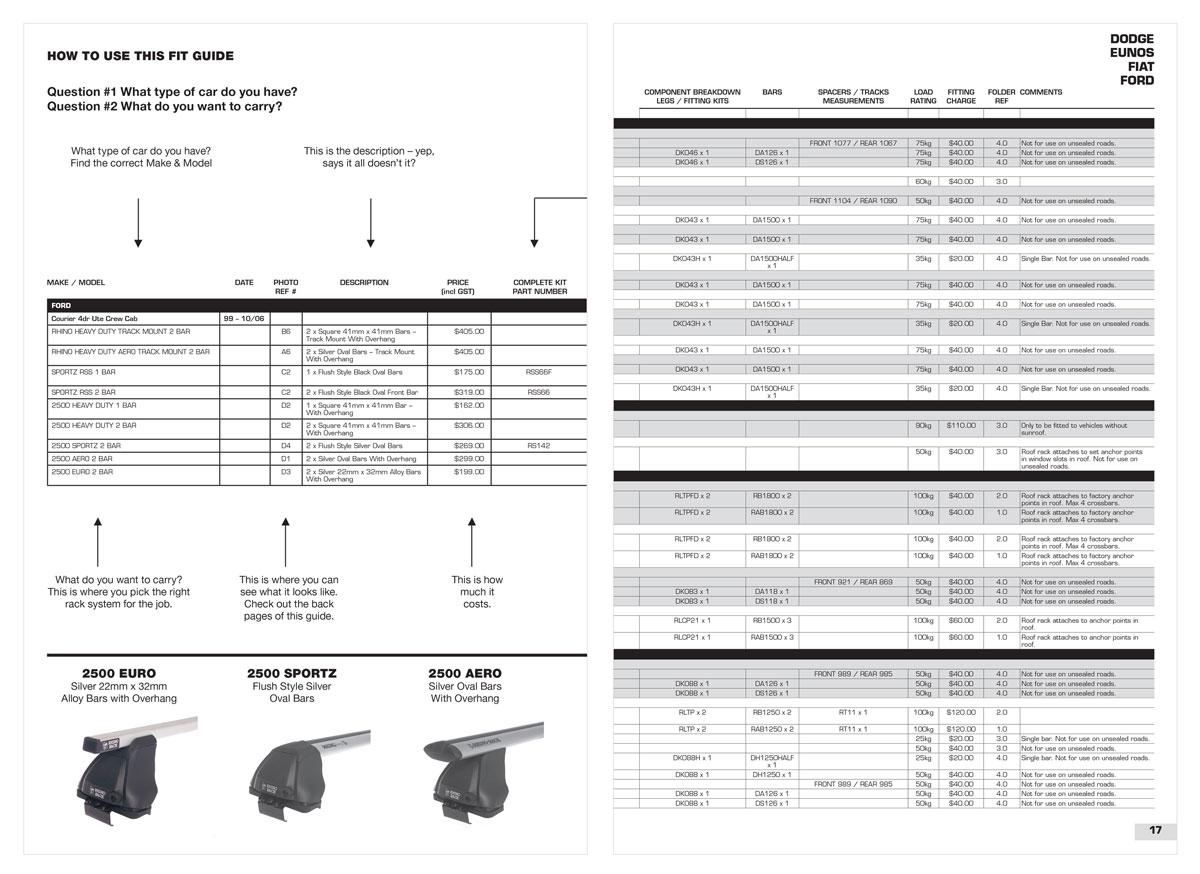This leading vehicle accessories manufacturer reduced production time for fit guides from one month to three days—with better results!
Rhino-Rack has been creating world-class roof racks since 1992, and is now the proud owner of Australia’s most diverse and innovative range of roof racks and accessories for tradesmen, sportsmen, sun-seekers and nature lovers.
Rhino-Rack has over 160 employees across its manufacturing and warehousing departments in Australia, New Zealand and the USA, and exports to 55 countries worldwide.
Promising quality design and affordable pricing every time, Rhino-Rack’s entire product range is made and tested to strict Australian standards. The company also works with vehicle manufacturers to keep up to date with the latest trends, tailoring its products to make sure they’re the very best on the current market.
The challenge: Maintaining up-to-date fit guides for an extensive product range
Prior to 2010, Rhino-Rack manually maintained its product data in a Microsoft Excel spreadsheet. This spreadsheet was used to create the Comprehensive Fit Guide, a printed guide for fitting each roof rack system to all models of vehicle, and a subset of the data was maintained in XML format for use on the company website.
The Comprehensive Fit Guide was produced in native language versions for each dealer market, including Australia, France, Germany, Israel, the United Kingdom, and the United States.
Keeping the guides up to date with new product and vehicle-fitting specifications was crucial for sales and installation, and printing schedules were tight—a missed production deadline could result in lost sales and, in some cases, the loss of deposits that had been paid to printers.
Although speed and accuracy in production were of paramount importance, Rhino-Rack’s production and proofing processes were both error-prone and slow, with data being exported from Excel into QuarkXPress for manual typesetting by the in-house designer.
Each version took up to a month to produce. With Rhino-Rack’s commitment to producing a new version of the Comprehensive Fit Guide every 1–2 months on a rolling schedule, the publishing production cycle was almost constant.
The solution: Centralised data management and automated guide composition
In 2010, whilst reviewing its production processes, the Rhino-Rack team realised that the company’s data management system needed an overhaul.
Maintaining a master set of product data in an Excel spreadsheet with an XML subset for the website was clearly inefficient and error-prone, so the team decided to modernise the system and utilise the versatility of XML by installing a new XML-based database.
The database was initially populated with the existing XML data from the website and further augmented by the data from Excel.
Once the new database was up and running, data could be centrally managed, with different layers of information being used for a variety of purposes.
A subset of the data still went to the website, while a full set of data—including all technical specifications for fitting—could be easily used to publish the Comprehensive Fit Guide.
The next step in improving the production process was to automate the composition of the guides using Typefi Desktop, Typefi’s single-user on-premises automated publishing solution.
As the content for the Comprehensive Fit Guide was now contained in a defined structure within the XML database, it was a relatively simple process to map the XML structure to new templates for production.
The existing QuarkXpress design templates were replaced with updated Adobe InDesign templates for seamless integration with Typefi Desktop.
With the single click of a button, Typefi Desktop extracted the most current data from the XML database and automatically composed it into the correct fields in the pre-prepared design templates, ready for printing in minutes.

Faster guide production with better results
Jake Boulton, Rhino-Rack’s Web Projects Manager, estimated that total production time for the Comprehensive Fit Guide decreased by 75% after implementing the new system.
The accuracy of product data was more easily maintained throughout the entire process, and late changes to data no longer meant time-consuming layout modifications, as information was simply updated at the source and then run through Typefi again to create the final output.
“Using Typefi Desktop, our production time greatly reduced, from one month down to three to four days,” Jake said.
“As well as much faster production turnaround, automating composition has resulted in a noticeable reduction in errors. That’s really important for us.”
Ready to take the first step towards revolutionising your publishing?
We’ll work with you to understand the publishing challenges you’re facing and determine which Typefi solution best suits your budget and production requirements. Start by telling us a bit about your publishing needs and we’ll be in touch!

